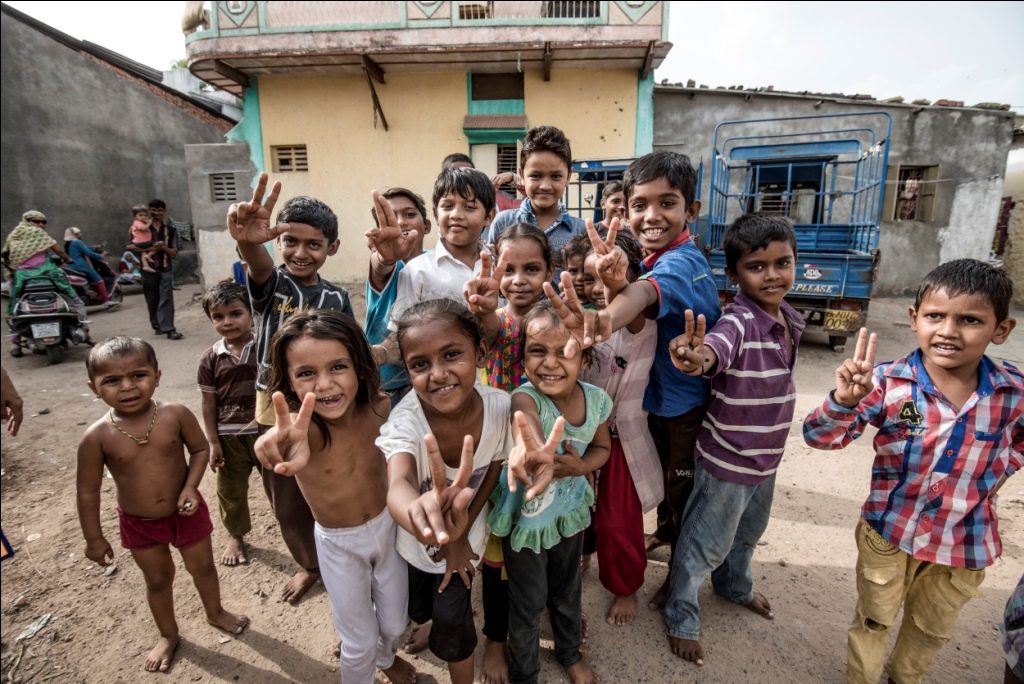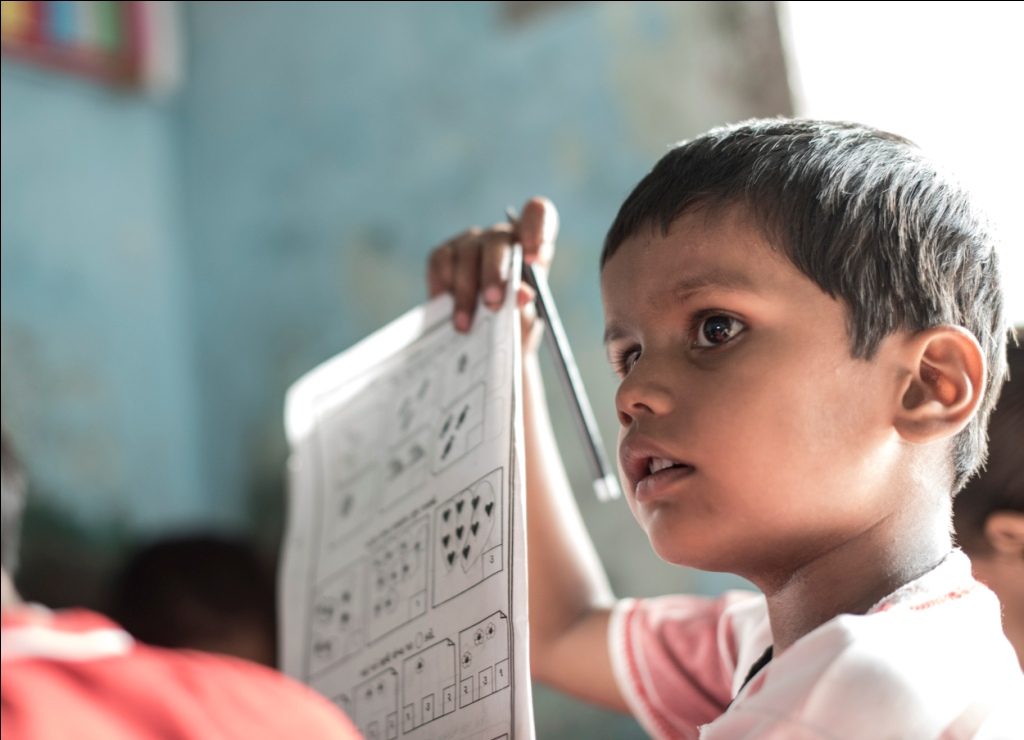Elementary Program (Grades 1-3)
- Elementary Program in Urban areas
Gyan Shala starts this program in such slums where it finds lots of young children loitering in streets during regular school timing, which is taken as a more effective evidence of children dropping out of school system compared to any formal survey which might or might not show universal enrollment.

Gyan Shala program is run like any formal school, except that various grade classes are not held in the same building, and are instead held in nearby rooms hired within the community where children live. This ensures that the parents have no hesitation in sending even a girl child to the school, and there is no cost of commute to school, either of time or transport cost.
This program is designed to lay a strong foundation stage of the school cycle, which would facilitate higher retention/ continuation and success in later years of schooling. The program admits children of age group 5-6 years in grade 1 and enables them to acquire the terminal competencies of grade 3 State curriculum in 3 years, even if they had no pre-schooling.
Main features:
- Classrooms nearby homes/ communities
- Curriculum content made suitable to the child’s natural learning style
- Pedagogical approaches adapted for the needs of the children with key lessons learned from the successful examples across World (from programs and experts)
- Use of human resources available locally and easily at each level
- Regular training of all categories of the staff
- Systemic planning for organized support to teachers and children in the form of weekly senior teacher visit
Subjects covered and Class transaction methodology adopted
Initially, the Program had three major subject streams, namely Local Language (Gujarati, Hindi, Bangla etc.), Math and Project work. The latter covered the environmental/ social studies module of the state/national curriculum, but more importantly, it helped the children to learn independently. This module gave opportunities to practice, refine, and develop some skills that Howard Gardner refers as Multiple Intelligences.
In addition to the above three subjects, English is also introduced as a second language, as the parents shared their concerns for the same.
Gyan Shala considers the class-time to be the most important resource of any school system, and places maximum emphasis on its optimal utilization, as the major instrument for children to learn well. The school time is divided into activities-periods of 15-20 minutes to match the typical attention span of small children, with language and math-related activities claiming around 60 percent of the class time. Gyan Shala integrated extra-curricular activities in the daily class schedule and allocated these a space comparable to individual math, language or project modules.

Once every year, children in one class location stage a 2-3 hour cultural event for which they invite elders from their community. That gave an opportunity to each child in Gyan Shala to perform in public.
The program follows the State curriculum, while pedagogy places emphasis on children doing individual and group work each day in the class under teacher supervision. Supply of high-quality learning material is given huge importance, with each child getting to work on one-page worksheet each day for each subject stream. A teacher spends around 20% of class time in full class teaching-exposition, and 30 % on individual attention to each child. The remaining time is given to group teaching-tuition and supervision of group work by children.
Classroom organisation and Mainstreaming
Classrooms have furniture, suitable for children, and functional lighting and ventilation. The State-national curriculum is fully implemented so children could be transferred to any other regular government or private school into the next grade class on completion of any grade education in Gyan Shala. Class duration is kept 3.5 hours, without any break (children are allowed to have an individual break for either drinking water or attending natural requirement on an individual basis as per their needs, so as to avoid academic time loss of the group.) Classes are held for a minimum of 220 days in an academic year. Our reviews have shown that the number of hours of class time devoted to the core subjects of language, math, and pre-science/EVS is comparable to most full-day schools, as there are no breaks or intermission in 3.5 hours of class or organized extra-curricular activities. On completion of three years elementary module, most children are mainstreamed in regular schools in grade 4, except for a small group in Ahmedabad who continue in grade 4 Gyan Shala classes and are mainstreamed in higher grade classes later in recognized schools, according to the preference of children-parents, using the provisions under the Right to Education (RTE) act.
The children mostly receive free education, including free supply of stationary and books, and other learning material. An attempt is made to secure part financial support of the Government through Sarva Shiksha Abhiyan (SSA), which also enabled the supply of mid-day meal.
Profile of Teachers and Training
The educational support to the children is delivered by a 6 tier academic team. The class teachers are recruited from the community so they are comfortable in working in a poor community setting. A typical student-teacher ratio is around 25 across the grades. The class teachers for grade 1-3 are required to have passed higher secondary, though many young graduates too take up the job. One senior teacher is engaged to supervise every 8-10 classes, who have a minimum of graduate education. The teachers-teams are supported by a two-tier team of curriculum designers and teacher trainers for various subject streams. A group of senior supervisors take care of administrative aspects in the field and insulate educational processes from other disturbances. Teacher training is given large resource support and management attention, which comprises of 12 days orientation training at the start of teacher-role, supplementary training of one day each month and 4-5 days during festival break. Every year, 8-10 days refresher training is organized during summer break. Weekly visit of a senior teacher to each class also acts as teacher-training cum demonstration exercise.
Towards the end of 2017-18, around 27,000 children studied in around 1100 classes in various slums in seven cities across 3 states. The proportion of girls and boys in Gyan Shala remained almost equal and minority representation exceeded their proportion in the populations-geographies served (more than 60% for backward classes).
In 2017-18, the number of classes and children at various locations were as under:
| Sr. No | Location | Centers | Children | Boys | Girls | Yearly Average Cost per Child (INR) | |||
| 1 | Ahmedabad | 231 | 5284 | 2582 | 2702 | 3972 | |||
| 2 | Surat | 80 | 1909 | 986 | 923 | 3157 | |||
| 3 | Patna | 321 | 8517 | 3772 | 4745 | 2631 | |||
| 4 | Kolkata | 82 | 1637 | 792 | 845 | 3285 | |||
| 5 | Lucknow | 115 | 2428 | 1146 | 1282 | 3279 | |||
| 6 | Kanpur | 121 | 2989 | 1349 | 1640 | 2804 | |||
| 7 | Farukkhabad | 156 | 4133 | 2127 | 2006 | 2239 | |||
| Total | 1106 | 26897 | 12754 | 14143 | 2979 | ||||
Student Assessments
The program team conducts two written and two oral assessments in each grade to assess children’s progress and plan remedial-corrective steps. These records are kept along with monthly attendance of all children to enable performance tracking.

Independent assessment of children’s performance is conducted by Educational Initiatives for the cohort completing grade 3, using ASSET test, to provide feedback about the performance in comparison to other, mostly elite schools (CBSE) of India taking ASSET test.
Detailed student assessment reports for the period 2009-2018 can be accessed through the ‘External Assessments’ tab in the ‘Reports’ section.
- Elementary Program in Rural areas
In the wake of severe damage to school infrastructure by the Gujarat Earthquake in 2001, Gyan Shala started its grades 1-3 classes in two taluka/blocks of Surendranagar district, Dhragandhra and Patdi, bordering the little Rann of Kutchh. The program had around 2000 children in 60 classes in 20 villages.
Most government school buildings got repaired, and these started functioning in all villages by the end of 2003, but the local villagers found the quality of Gyan Shala schools much better and wanted these to continue, so the program continued for four years. The program had to close due to funding and regulatory constraints.
The rural program performed as well as the urban program in terms of children’s learning. The only area of difference was among teachers, who were mostly women in urban areas, but almost all male in rural areas. We could not get educated girls in the villages that were willing to teach poor children. In terms of unit cost too, the two program components came on par.
In 2002-03, Yuva Shakti (Jan-Vikas) approached Gyan Shala to support their education initiatives in Halol taluka of Panchmahal district to build communal harmony, after riots of 2002. For four years, 52 classes were supported academically by Gyan Shala but managed Yuva Shakti.
